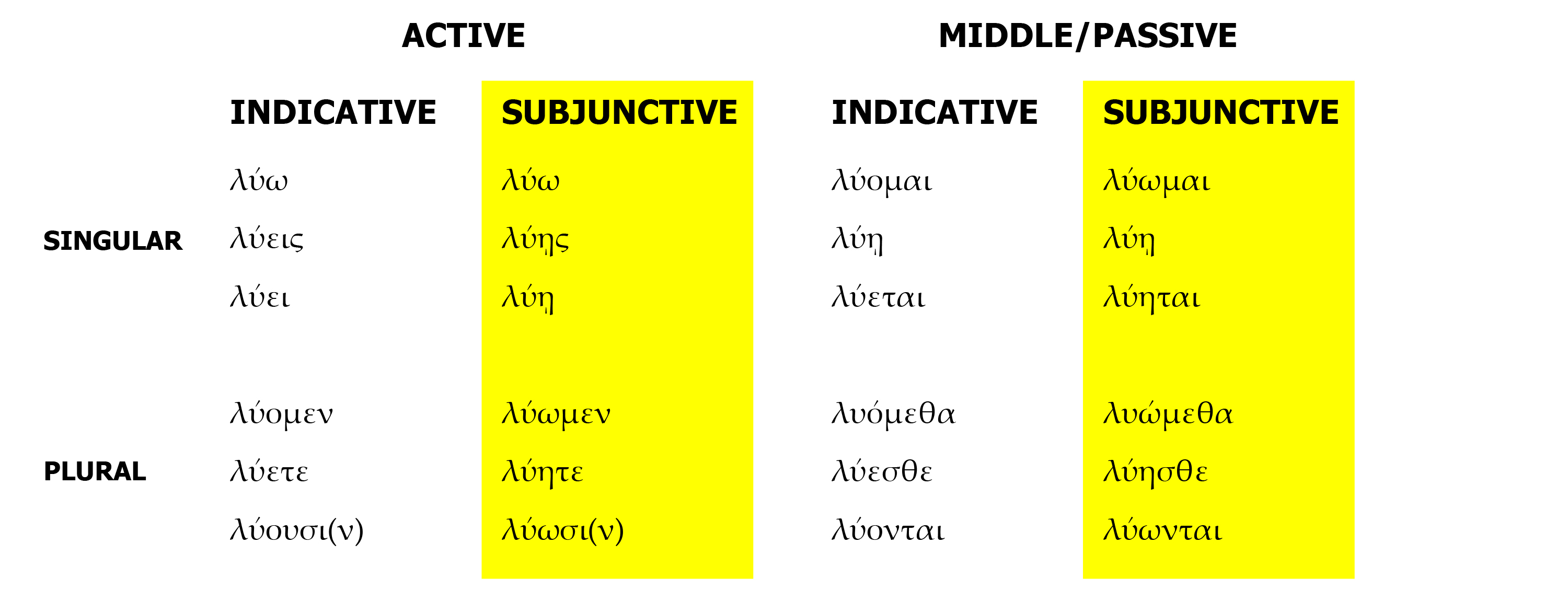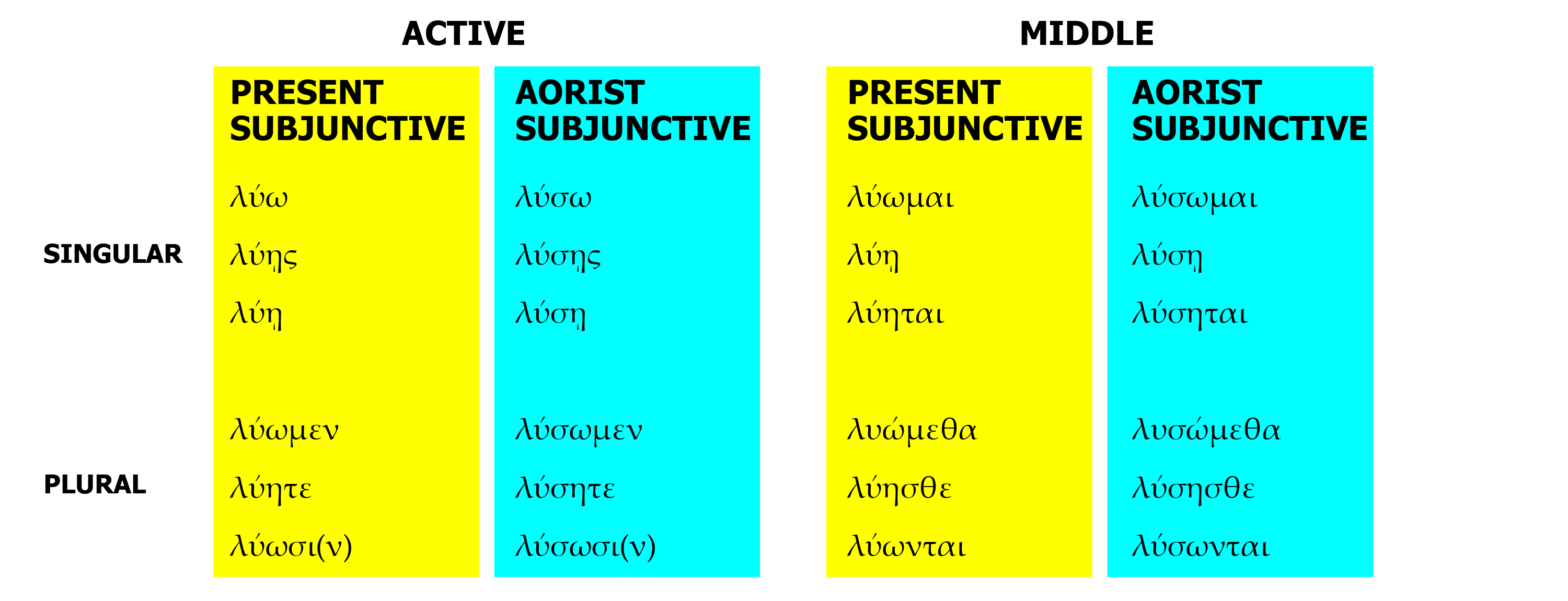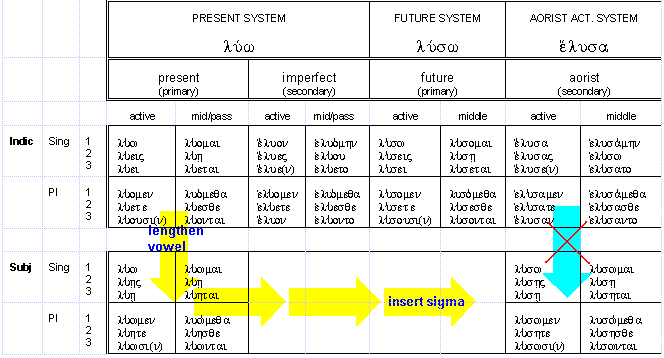Lesson 9 – Subjunctive Mood, Morphology, Syntax, Hortatory Subjunctive, Particles & Conjunctions used with the Subjunctive
Subjunctive Mood
Up to this point, we have focused on the indicative mood. In Course 1, Lesson 2, we learned that the different moods indicate different degrees of contingency. The degree of contingency inherent in the indicative mood is zero.
Now we come to the subjunctive mood which indicates some contingency. Greek grammarians had various names for the subjunctive mood, but one name was ἡ διστακτικὴ ἔγκλισις , “the mood expressive of doubt.” In contrast, the indicative mood was called ἡ ὁριστικὴ ἔγκλισις , “the definitive mood.” (Notice the word ὁριστική and think back to our discussion of the significance of the term, aorist.)
The subjunctive mood is illustrated in the following sentences:
Might you eat some spinach?
Were I to eat spinach, I would get sick.
Should I get sick, I would not be able to go to work.
If you were unable to go to work, you would not be paid.
In English, we use the words “were,” “should,” “might,” or “would” when we are speaking in the subjunctive mode. In each of the sentences above, only the possibility of eating spinach, or of being sick, or of being unable to go to work, or of not being paid is being considered. The reality remains contingent upon future developments. The case is contemplated with the action being hypothesized. Notice that although we will talk about presentsubjunctives, the subjunctive naturally looks to the future for the resolution of the contingency.
In the following sentences from the Greek New Testament, all of the verbs, with the exception of θέλομεν, are in the subjunctive mood:
διδάσκαλε, θέλομεν ἵνα ὃ ἐὰν αἰτήσωμέν σε ποιήσῃς ἡμῖν.
Teacher, we desire that whatever we might ask you, you would do for us. (Mk. 10:35)
ἐὰν ἔχητε πίστιν καὶ μὴ διακριθῆτε, οὐ μόνον τὸ τῆς συκῆς ποιήσετε, ἀλλὰ κἂν τῷ ὄρει τούτῳ εἴπητε…
If you would have faith and would not doubt, not only the thing of the fig tree would you do, but also to this mountain you would say…(Mt. 21:21)
The subjunctive mood is largely disappearing from English, or perhaps it is more accurate to say that English usage is increasingly relying on indicators of contingency other than the words should, might, would, et al. Accordingly, your translation of subjunctives may be less characterized by these words than is the King James Version of the Bible.
Morphology
In learning to recognize subjunctive forms, we only need concern ourselves with three principal parts. Other than ten occurrences of perfect active subjunctive forms of οἶδα, (εἰδῶ twice, εἰδῇς once, εἰδῶμεν once, and εἰδῆτε six times) all subjunctives in the Greek New Testament are either present or aorist.1 Hence the principal parts with which we will concern ourselves are the 1st, 3rd, and 6th.
Present Subjunctive
Recognition of the subjunctive requires remembering one characteristic trait: The connecting vowel is lengthened.
1st principal part stem + lengthened connecting vowel + primary tense ending
The present active and middle/passive forms of the subjunctive look exactly like their counterparts in the indicative mood except that the connecting vowel has been lengthened. Where a ι follows an ε that is lengthened to η , the ι drops to a subscript. In the active 1st person singular where the indicative already shows ω, there is no difference between the indicative and subjunctive forms. Similarly, in the middle 2nd person singular where contraction of the connecting vowel with the personal ending has formed ῃ, there is no difference between the indicative and subjunctive forms. Finally, in the active 3rd person plural where the indicative has a long diphthong ου, the subjunctive has ω. Compare the present indicative forms with the present subjunctive forms in the table below.
Compare PRESENT INDICATIVE and PRESENT SUBJUNCTIVE
forms

Aorist Subjunctive, active and middle voices
All aorist active and middle subjunctives are formed on the stem of the 3rd principal part. However, because they do not have the augment found in the indicative mood, nor do they have the α characteristic of 1st aorist indicative forms, and because they use primary tense personal endings rather than secondary tense personal endings, they will often look more like present forms than aorist forms. This is especially true of 1st aorist subjunctives.
1st AORIST WITH σα, ACTIVE & MIDDLE
For those first aorist verbs wherein the 3rd principal part less the characteristic σα is identical to the 1st principal part, the aorist subjunctive is almost identical to the present subjunctive.
3rd principal part stem ending in σ + lengthened connecting vowel + primary tense ending
The only difference is the insertion of σ before the lengthened connecting vowel and personal ending. Compare Aorist Subjunctive forms with the Present Subjunctive forms in the table below.
Compare PRESENT SUBJUNCTIVE and AORIST SUBJUNCTIVE
forms

Look inside the back cover of your text book. There you will see the six principal parts of λύω conjugated for the various moods. By this time, you should have become very familiar with the upper portion of that table, the portion representing the indicative mood. You will find it helpful eventually to be able to picture that entire table. And you will find it particularly helpful if you can learn to think of the various columns and rows in terms of their characteristic traits, to the extent that there are such.
But it’s also easy to be led astray by an expectation of a pattern that is not there. In particular, you might expect that you could start at the top of the aorist column, and form the various moods, first forming the subjunctive as a variation of the indicative, then forming the imperative by making some minor change, and so on. However, this approach may lead to confusion. It may result in trying to create subjunctive forms having the σα characteristic of 1st aorist indicatives, having secondary personal endings, and perhaps having an augment, none of which are found in aorist subjunctives. Instead, try imagining an aorist subjunctive by first thinking of the present subjunctive. For non-liquid first aorist subjunctives, the only difference will be the σ at the end of the stem.
Below is a representation of the upper left quadrant of a table similar to the one in the back of your book. It shows the first three principal parts and the indicative and subjunctive moods. Notice the aqua arrow with the red X over it. The point is, for first aorist verbs, don’t try to think of an aorist subjunctive form by first thinking of an aorist indicative form. Instead, follow the thought process represented by the yellow arrows. First think of the present indicative forms. Then, for present subjunctive forms, lengthen the connecting vowel. Finally, with the present subjunctives in mind, the 1st aorist subjunctives can be imagined by inserting a sigma after the verb stem and before the connecting vowel of the present subjunctive.

Thus we remember that the 1st aorist subjunctive has primary personal endings like the present tense, does not have σα, and of course, does not have an augment.
This approach is a bit unorthodox, and the danger is you will forget that the aorist subjunctive is built on the stem of the 3rd principal part after all. Therefore, realize the aorist subjunctive form you end up with uses the stem of the 3rd principal part, but without an augment and without the characteristic α, and with primary tense endings rather than secondary tense endings.
LIQUID 1st AORIST SUBJUNCTIVES AND 2nd AORIST SUBJUNCTIVES, ACTIVE & MIDDLE
If you keep in mind the fact that the aorist subjunctive is built on the stem of the 3rd principal part, liquid aorists and 2nd aorists will not present any special problem. Just remember that, as in the indicative mood, the stem of liquid aorist subjunctives and 2nd aorist subjunctives will vary from that seen in the present subjunctive, and no σ will be added to the stem.
3rd principal part stem + lengthened connecting vowel + primary tense ending
Aorist Passive Subjunctives
Aorist passive subjunctives are built on the stem of the 6th principal part. As in the aorist active and middle subjunctive forms, the primary tense endings rather than the secondary tense endings are used. And perhaps even more unexpectedly, it is the active primary tense endings rather than the passive primary tense endings that are used.
6th principal part stem ending in θη + primary tense active endings
The final η of the stem contracts with the connecting vowel according to the rules you have already learned. The accent follows the rule you learned for contract verbs: If the contracted syllable is formed from two syllables, one of which would have been accented in the uncontracted form, then the contracted syllable will have a circumflex. This will be the case in all aorist passive subjunctive forms.

1And remember that the perfect οἶδα is used with present meaning.
Syntax
Only in the indicative mood is absolute time indicated by tense. And even there, as previously noted, the fundamental idea of tense is kind of action, not time of action. Upon leaving the indicative mood, we enter a world where time of action, if indicated at all, is only relative to the main verb.
Remember that the present system (including both the present tense and the imperfect tense) is used when the speaker wishes to indicate progressive or ongoing action. The aorist tense is used when the speaker does not wish to indicate ongoing action. Of course, as previously noted, this doesn’t mean the action was not ongoing. It simply means the speaker does not call attention to the ongoing nature of the action, whether or not the action was ongoing. This distinction between the present tense and the aorist tense will hold true in the subjunctive mood. And in independent clauses, this will be the only difference between a present subjunctive and an aorist subjunctive. There will be no difference indicated in the time of the action. 1 Cor. 14:23
ἐὰν οὖν συνέλθῃ ἡ ἐκκλησία ὅλη ἐπὶ τὸ αὐτὸ καὶ πάντες λαλῶσιν γλώσσαις, εἰσέλθωσιν δὲ ἰδιῶται ἢ ἄπιστοι, οὐκ ἐροῦσιν ὅτι μαίνεσθε;
If therefore the whole assembly should come together at one place and all are speaking in languages, and novices or unbelievers should come in, will they not say you are maniacs? (1 Cor. 14:23)
λαλῶσιν is a present subjunctive. It describes action that is ongoing when novices or unbelievers walk in.
συνέλθῃ and εἰσέλθωσιν are aorist subjunctives. συνέλθῃ describes some specific coming together rather than a habit of coming together. Similarly, there is no durative idea in εἰσέλθωσιν. The unbelievers’ entry is not a process.
But notice that there is no past time indicated by the aorist tenses. συνέλθῃ anticipates some hypothetical future time. εἰσέλθωσιν describes an entry that takes place in the time framed by the speaking in languages.
However, in some circumstances, present and aorist subjunctives may indicate relative time, specifically, time that is relative to that of another verb. Hear Nigel Turner with reference to subjunctives in relative clauses:
The use of pres. or aor. subj. bears little or no relation to the Aktionsart. In the papyri, the difference appears to be that the pres. indicates that the time of the subordinate clause is coincident with that of the main (or durative action, if relatively past), while the aor. indicates a relatively past time.
(Turner, A Grammar of New Testament Greek, vol. 3: Syntax, p. 107.)
Consider the following example:
ὃς ἂν ἀπολύσῃ τὴν γυναῖκα αὐτοῦ μὴ ἐπὶ πορνείᾳ καὶ γαμήσῃ ἄλλην μοιχᾶται.
Whoever would put away his wife, not for fornication, and marry another woman is committing adultery (Mt. 19:9)
The aorist subjunctives ἀπολύσῃ and γαμήσῃ are actions that take place prior to or at the inception of the adultery.
Hortatory Subjunctive
In the first person plural, the subjunctive may be used as an exhortation. If you can imagine a first person imperative, it has about that meaning. Consider the following examples of the 1st person plural subjunctive
ἔπειτα μετὰ τοῦτο λέγει τοῖς μαθηταῖς, Ἄγωμεν εἰς τὴν Ἰουδαίαν πάλιν.
Then after this he says to the disciples, Let’s go into Judea again. (Jn. 11:7)
Ἐγείρεσθε, ἄγωμεν ἐντεῦθεν.
Arise, let’s depart from here. (Jn. 14:31)
μὴ γινώμεθα κενόδοξοι.
Let us not become vainglorious. (Gal. 5:26)
Particles & Conjunctions used with the Subjunctive Mood
μή
We have been using the negative particle οὐ (οὐκ before an unaspirated vowel, οὐχ before an aspirated vowel). However, with verbs not in the indicative mood, we are more likely to encounter the negative particle, μή. A.T. Robertson wrote, “It is the negative of will, wish, doubt. If οὐ denies the fact, μή denies the idea.” (Grammar of the Greek New Testament, p. 1167) Consequently, οὐ is naturally the negative particle we should expect to see with verbs in the indicative mood, and μή is the negative particle we should expect to see with verbs in the subjunctive mood.
μή & οὐ in Questions
That is not to say you won’t encounter μή with the indicative mood. You will see μή with the indicative mood in a question asked with the expectation of a negative response. Keep in mind Robertson’s description of μή as “the negative of will, wish, doubt,” and consider the following occurrences of the interrogative form μήτι:
After Jesus has healed a man who had been blind and mute, the crowds are moved to ask,
μήτι οὗτός ἐστιν ὁ υἱὸς Δαυίδ;
This is not the son of David is it? (Mt. 12:23)
Jesus’ power to do miracles prompted the question, but the people who asked it were dubious. Jesus wasn’t the sort of man they expected their Messiah would be.
The woman who was astonished at Jesus’ knowledge of her personal relationships, but found Jesus’ response to her theological question unsatisfying, told others in her village about him and asked
μήτι οὗτός ἐστιν ὁ Χριστός;
This is not the Christ is it? (Jn. 4:29)
Blass & Debrunner cited the two rhetorical questions in Lk. 6:39 to illustrate the difference between μή and οὐ in questions.
οὐ (…often οὐχί) when an affirmative answer is expected, μή when a negative one is expected. Thus Lk 6:39 μήτι δύναται τυφλὸς τυφλὸν ὁδηγεῖν; (‘A blind man can’t lead a blind man, can he?’ Answer: ‘Certainly not’); οὐχὶ ἀμφότεροι εἰς βόθυνον ἐμπεσοῦνται; (Answer: ‘Of course’) (A Greek Grammar of the New Testament and Other Early Christian Literature, p. 220, ? 427.)
In connection with this point, consider again the question in 1 Cor. 14:23: οὐκ ἐροῦσιν ὅτι μαίνεσθε; The expected response is, “Of course they will!”
ἐάν, ὅταν
We have already learned to expect the particle ἄν in Type II conditional sentences. In such sentences there is a high degree of contingency. The apodosis is contingent upon the protasis, and the protasis is assumed to be contrary to fact. That precedent will make it easy for you to associate ἄνwith contingency. We will see it often used with the subjunctive mood. Make special note of ἄν combined with εἰ to form ἐάν and combined with ὅτε to form ὅταν.
| εἰ | usually with the indicative mood | ||
| ἐάν | (εἰ + ἄν) | if | usually with the subjunctive mood |
| ὅτε | when | usually with the indicative mood | |
| ὅταν | (ὅτε + ἄν) | whenever | usually with the subjunctive mood |
ἵνα
ἵνα, that, in order that, is a conjunction used with the subjunctive mood that begins a clause indicating the purpose or goal of something.
οὗτός ἐστιν ὁ κληρονόμος· ἀποκτείνωμεν αὐτόν, ἵνα ἡμῶν γένηται ἡ κληρονομία.
This one is the heir. Let’s kill him, in order that the inheritance might become ours. (Lk. 20:14)
οὗτος ἦλθεν εἰς μαρτυρίαν, ἵνα μαρτυρήσῃ περὶ τοῦ φωτός
This one came as a witness in order that he might testify concerning the light. (Jn. 1:7)
ἵνα is often used with the idea of purpose very much weakened, or non-existent.
Διδάσκαλε, θέλομεν ἵνα ὃ ἐὰν αἰτήσωμέν σε ποιήσῃς ἡμῖν.
Teacher, we desire that whatever we might ask you, you would do for us. (Mk. 10:35)
οὕτως οὐκ ἔστιν θέλημα ἔμπροσθεν τοῦ πατρὸς ὑμῶν τοῦ ἐν οὐρανοῖς ἵνα ἀπόληται ἓν τῶν μικρῶν τούτων.
Thus it is not the will of your father in heaven that one of these little ones should perish. (Mt. 18:14)
ὃς ἐάν
This expression is often used where English will require “whoever” (neuter, “whatever”)
Διδάσκαλε, θέλομεν ἵνα ὃ ἐὰν αἰτήσωμέν σε ποιήσῃς ἡμῖν.
Teacher, we desire that whatever we might ask you, you would do for us. (Mk. 10:35)
ὃ γὰρ ἐὰν σπείρῃ ἄνθρωπος, τοῦτο καὶ θερίσει
For whatever a man sows, this also he will reap. (Gal. 6:7)
